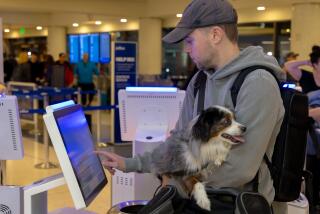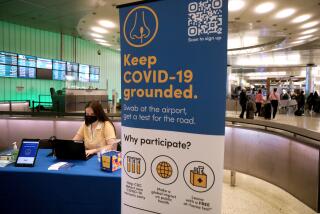Most unwelcome traveling companions: flu and cold bugs
- Share via
TWO recent studies confirm travelers’ worst suspicions: Airplanes and hotel rooms are fertile grounds for spreading cold and flu bugs.
Harvard scientists confirmed that flu is spread on planes in a study released last month. Researchers found that the decline in air travel after the Sept. 11 terrorist attacks delayed the onset of the 2001-02 flu season in the United States.
In hotel rooms, many surfaces -- especially door handles, light switches and faucets -- can swarm with cold viruses that linger for hours after the person has checked out, University of Virginia researchers reported at a recent science conference.
Catching the flu on a plane “is easier than it is in many other circumstances because the air in planes is recirculated,” says Dr. Kenneth McIntosh, professor of pediatrics at Harvard Medical School.
His statement is borne out by research by John Brownstein, an instructor of pediatrics at Harvard Medical School and Children’s Hospital Boston, and his co-researchers. The team tracked the rate and timing of flu’s spread across the United States for nine seasons from 1996 to 2005.
After the terrorist attacks, when air travel declined dramatically, they noticed two things: “The virus spread slower and peaked later,” Brownstein says. The respiratory illness has tended to peak around Feb. 17 in recent years, but after the Sept. 11 attacks, the peak was delayed until March 2, researchers found.
They also found that the number of airline passengers in November, especially around the Thanksgiving holiday, predicts the rate at which flu spreads for the season. November 1997, for example, had the lowest airline passenger volume of the years studied -- including November 2001 -- and flu spread the slowest in the 1997-98 season.
“Influenza virus is contained in a droplet of moisture or even dust,” McIntosh says. It’s often spread by person-to-person contact when someone coughs or sneezes, he says. You also can become infected by touching an object with flu virus on it and then touching your mouth or nose, according to the Centers for Disease Control and Prevention in Atlanta.
The amount of virus it takes to infect you depends on your immune state, McIntosh says. Babies who have never had the flu require a tiny dose to become infected. “If you are older and have some underlying immunity, it requires more,” he says. Annually in the U.S., as much as 20% of the population contracts influenza, the CDC estimates.
Cold viruses can linger on hotel room surfaces even 18 hours after initial contamination, according to a study conducted by University of Virginia Health System researchers and presented last month at a conference in San Francisco.
Reckitt Benckiser Inc., the maker of Lysol and other cleaning products, funded the study, but the research did not involve the use of the product, says Dr. Owen Hendley, a professor of pediatrics at the university and the study’s lead author.
Hendley’s team asked 15 volunteers infected with rhinovirus, thought to cause half of all colds and to be the most common cold virus, to check into hotel rooms in the afternoon, go about normal activities and check out the next morning.
Before the cleaning crew came in, Hendley’s team sampled 10 surfaces in each room where the guests had stayed to see if cold viruses lurked. They found 35% of the 150 samples tested were still contaminated. Most commonly contaminated items: door handles, light switches, faucets, telephones and TV remote controls.
For Hendley, a longtime cold virus researcher, the study shows that “surfaces may be more important than I thought in spreading the virus.”
So does a traveler have a fighting chance of staying healthy? Yes, if you know what steps to take to minimize your risk:
* On the plane ride, “stay well-hydrated and avoid alcohol,” says Dr. David B. Baron, chief of staff at Santa Monica-UCLA Medical Center and a physician in Malibu. If you do drink an alcoholic beverage, he says, limit it to one. “Alcohol has a direct weakening effect on the immune system,” he says. To increase hydration, drink water or other healthy beverages without caffeine, he says.
* Use a saline nasal spray. “If your nose is all dried out, it is easier for a germ to get in and set up its tent,” Baron says. (Toiletries of 3 ounces or less placed in a clear, one-quart-sized zip plastic bag are allowed in carry-on bags, according to the Transportation Security Administration.)
* Hand gel sanitizers can help combat flu viruses, Baron says.
For cold viruses, washing your hands with soap and water is best, he and others say.
“Alcohol [in sanitizers and disinfectant wipes] can kill influenza viruses but not rhinovirus,” says Dr. Birgit Winther, a co-researcher on the hotel room study and an assistant professor of otolaryngology at the University of Virginia Health System in Charlottesville. The mechanical action of washing removes the cold virus, she says.
* Studies on Vitamin C’s value in preventing colds have had mixed results for years, but Baron says 500 milligrams a day may help, depending on your doctor’s advice.
* Get your flu shot before departure, Baron says. Best times to get one are in October and November, McIntosh says. “But anytime is OK before you get exposed.”
* Watch where you place your hands. Even in the germiest environment, hygiene and common sense can help, Hendley says. “You can pick up a virus by flipping a light switch or dialing a phone, but it still doesn’t infect you until you put your finger in your eye or nose.”
*
More to Read
Sign up for The Wild
We’ll help you find the best places to hike, bike and run, as well as the perfect silent spots for meditation and yoga.
You may occasionally receive promotional content from the Los Angeles Times.






